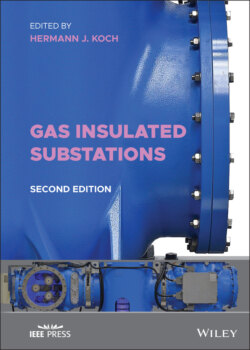Читать книгу Gas Insulated Substations - Группа авторов - Страница 13
Foreword Hitachi Energy
ОглавлениеGas‐insulated switchgear (GIS) operates invisibly, safely, and reliably and is often hidden in buildings or other structures. No movement can be seen, just a faint hum betrays the flow of bulk AC power. Perhaps that's why there has only been this one comprehensive reference work on GIS technology, further remarkable since it was only first published in 2014. The history of GIS dates back several decades, and its implementation has been very successful. GIS technology originated in 1936, when a Freon‐filled GIS assembly, rated at 33 kV, was demonstrated in the United States. Later, in the mid‐1950s, sulfur hexafluoride gas (SF6) was discovered, a gas with excellent insulating and arc‐extinguishing properties. By the mid‐1960s, GIS was sufficiently well developed to be commercially viable and appealing to a broader market. Today, GIS is an established technology that allows for safe, highly reliable operation in confined spaces, owing to its being enclosed and to its significantly reduced footprint compared to air‐insulated switchgear (AIS). This revolutionary technology was a key enabler for urbanization. Occupying only 10% of the volume required by the equivalent AIS, it allows flexible placement of substations within cities to supply safe and reliable power. Substations are no longer taking up acres of open spaces but can hide within buildings, underground, or on rooftops.
Although at first glance looking seemly uncomplicated, a closer examination reveals the engineering investment, the complexity in the variety of configurations, and the installation and testing effort found in a typical GIS installation. This handbook helps to decipher GIS technology, to present it in a clear and explanatory way, and gives a comprehensive overview of the subject, making it both interesting and indispensable for anyone with this technology. This includes those who want to start (or have already started) their career with manufacturers or end‐users of GIS. Descriptions of practical application examples, as well as operation and maintenance requirements, make the book equally interesting for switchgear operators and decision‐makers in energy policy. I also particularly recommend this book to students, as this book provides the most comprehensive overview of the technology currently available.
Today, our power transmission systems are subject to new requirements and far‐reaching changes, ushering in a new era of electrical grids and switchgear. On the one hand, an enormous flow of electricity to large megacities often has to cross several thousand kilometers, from the energy sources to the end‐user with transmission voltages of 1100–1200 kV having been established. Secondly, a large expansion of the transmission grid is required due to global plans for the extensive integration of new renewable energies into the electrical energy supply. Especially in the case of large‐scale (multi‐GW) offshore wind farms, the connection to the onshore grid will be made by means of HVDC. The increasing demand for HVDC technology requires the adaptation of gas‐insulated switchgear. Finally, the latest developments in the development and use of eco‐efficient GIS solutions and the integration of digital techniques in design and diagnostics are worthy of special mention. It combines a low‐carbon footprint, superior reliability, and low lifecycle costs in a flexible product layout. These topics are described in the new chapter of this second edition of the GIS Handbook, further increasing its interest for all those who want to get to know and follow current and new development trends.
Finally, I would like to add that I am proud to have been able to make a modest contribution to the work of this group of authors, who are well known and esteemed by myself and others in the field.
Uwe Riechert
Switchgear expert, Hitachi Energy Switzerland Ltd
Zurich, Switzerland, November 2021
